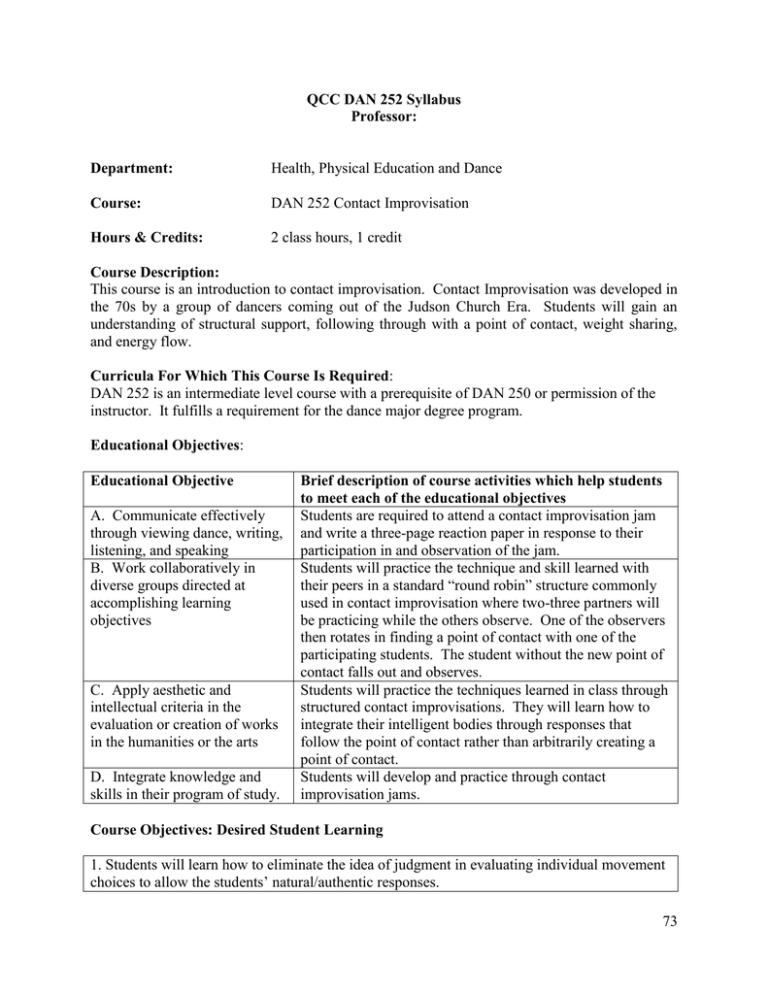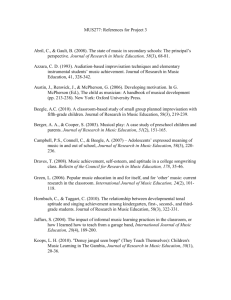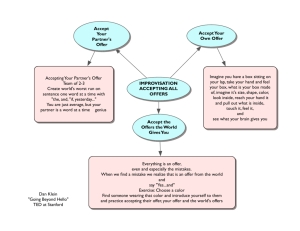This course is an introduction to contact improvisation. Contact... the 70s by a group ... QCC DAN 252 Syllabus
advertisement

QCC DAN 252 Syllabus Professor: Department: Health, Physical Education and Dance Course: DAN 252 Contact Improvisation Hours & Credits: 2 class hours, 1 credit Course Description: This course is an introduction to contact improvisation. Contact Improvisation was developed in the 70s by a group of dancers coming out of the Judson Church Era. Students will gain an understanding of structural support, following through with a point of contact, weight sharing, and energy flow. Curricula For Which This Course Is Required: DAN 252 is an intermediate level course with a prerequisite of DAN 250 or permission of the instructor. It fulfills a requirement for the dance major degree program. Educational Objectives: Educational Objective A. Communicate effectively through viewing dance, writing, listening, and speaking B. Work collaboratively in diverse groups directed at accomplishing learning objectives C. Apply aesthetic and intellectual criteria in the evaluation or creation of works in the humanities or the arts D. Integrate knowledge and skills in their program of study. Brief description of course activities which help students to meet each of the educational objectives Students are required to attend a contact improvisation jam and write a three-page reaction paper in response to their participation in and observation of the jam. Students will practice the technique and skill learned with their peers in a standard “round robin” structure commonly used in contact improvisation where two-three partners will be practicing while the others observe. One of the observers then rotates in finding a point of contact with one of the participating students. The student without the new point of contact falls out and observes. Students will practice the techniques learned in class through structured contact improvisations. They will learn how to integrate their intelligent bodies through responses that follow the point of contact rather than arbitrarily creating a point of contact. Students will develop and practice through contact improvisation jams. Course Objectives: Desired Student Learning 1. Students will learn how to eliminate the idea of judgment in evaluating individual movement choices to allow the students’ natural/authentic responses. 73 2. Students will learn the concepts of partnering and contact improvisation based on anatomical structural support. 3. Students will learn how to allow the body to respond and follow through with a point of contact. 4. Students will learn the basic concepts of weight sharing. 5. Students will learn how to move and respond to others in the group, to sense them and communicate with them through movement. Student Learning Outcomes Course Objectives 1. Students will learn how to eliminate the idea of judgment in evaluating individual movement choices to allow the students’ natural/authentic responses. 2. Students will learn the concepts of partnering and contact improvisation based on anatomical structural support. 3. Students will learn how to allow the body to respond and follow through with a point of contact. 4. Students will learn the basic concepts of weight sharing. 5. Students will learn how to move and respond to others in the group, to sense them and communicate with them through movement. Learning Outcomes A. Students will be verbally guided through improvisations with their eyes closed so that they can focus on the point of contact with their partner without judging themselves or each other. B. Through class discussions evaluating their experiences in the guided improvisations, they will learn how to use non-judgmental language. A. Students will practice creating a “base” for their partner to “play” on. Correlations to architectural support and skeletal support for safety in supporting someone’s weight will be explored. A. Students will participate in various improvisations where they will be required to respond to and follow through with a point of contact without arbitrarily abandoning one point of contact for another. A. Students will participate in group improvisations with the focus on safely sharing and giving weight with a partner through sensing and responding to a partner. A. Students will practice contact improvisation in pairs continually changing partners to practice spontaneous responses that connect with and communicate with their partner. Summary of Main Topics Covered in the Course: 1. 2. 3. 4. 5. 6. Eliminating judgment Anatomical Structural Support Body/mind coordination Responding to and following through with a point of contact Communication through movement Weight Sharing 74 7. 8. 9. Maintaining intention Contact Improvisation in Performance Individual Creative Voice Attendance Policy: Attendance is extremely important to your individual growth and understanding of the class material. Students with 3 or more absences will fail the course- no exception! Arriving late and/or leaving early or coming to class unprepared will result in a lower final grade. Note: Remember that lateness is a sign of disrespect of you and me. Be on time. Be prepared with your dance attire. Otherwise, two late arrivals and/or two non-participations of any kind (i.e. no dance attire) will count as one absence- no exception! Note: All absences will be considered in the final grade however for extreme emergencies (i.e. extended hospital stay) an “Incomplete” grade will be considered and discussed with the student. Save your absences for when you really need them. The development of the body instrument and the material in class accumulates. Learn to enjoy the discipline and weekly demands of attendance. Furthermore, the material learned in class cannot be replicated outside of class. It is not possible to make up any missed classes. Required Dance Attire: Students must wear appropriate dance attire. Leotards and tights or a tight fitting top and dance pants are acceptable. Jeans or any type of pants that button and zip are not acceptable. Baggy clothes are not acceptable. The professor must be able to see the alignment of the dancer. No loose hair! If you have long hair, it must be pulled back! No Jewelry! Text/Readings: Recommended Readings: Sharing the Dance: Contact Improvisation and American Culture By Cynthia J. Novack Methods By Which Student Learning Will Be Evaluated: A. B. C. D. E. Attendance and Participation Growth, Progress, and Development Reaction Paper on Dance Concert Mid-term evaluation Final Movement Project Grading Standards: A grade of A is given for superlative work that demonstrates a profound commitment to the course material, and further, that goes on to employ this material as a springboard for independent thought and work. A grade of B is given for very good work that completely fulfills all the requirements of the course in a conscientious and dedicated manner, and that demonstrates mastery of the course content. A grade of C is given for work that fulfills all the requirements of the course in a satisfactory manner, but that falls short of demonstrating rigor and mastery. 75 A grade of D is given for work that is unsatisfactory. A grade of F is given for work that fails to fulfill the requirements of the course as listed above Academic Integrity: Forms of Academic Integrity Violations Violations of academic integrity can occur in a number of ways. Acts of academic dishonesty include (the complete listing with definitions and examples is included in the main body of the QCC Academic Integrity code): A. Plagiarism – the inclusion of someone else’s words, ideas or data as one’s own work without acknowledging the source. B. Fabrication – the use of invented information or the falsification of research or other findings. C. Cheating – an act or an attempted act of deception by which students seek to misrepresent that they have mastered information on an academic exercise that they have not mastered. D. Academic Misconduct – any act to gain an undue academic benefit for oneself or to cause academic harm to another. E. Any other serious violations of academic integrity as established by the professor. 76



